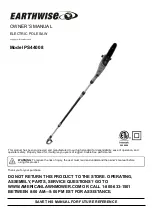
PTS 500 B2
GB
│
5
■
5. Service
a)
Have your power tool serviced by a qualified
repair person using only identical replace-
ment parts.
This will ensure that the safety of
the power tool is maintained.
Appliance-specific safety
instructions
Safety instructions for all saws
Cutting procedures
a)
DANGER! Keep hands away from
the cutting area and saw blade.
Keep
your second hand on the auxiliary
handle or motor housing. If both hands are
holding the saw, they cannot be injured by the
saw blade.
b)
Do not reach underneath the workpiece.
The blade guard cannot protect you from the
saw blade below the workpiece.
c)
Adapt the cutting depth to the thickness of the
workpiece.
Less than a full tooth height should
be visible below the workpiece.
d)
Never hold the workpiece that is being cut in
your hands or across your leg. Secure the
workpiece to a stable support.
It is important
to secure the workpiece properly to minimise
the risk of body contact, the saw blade jamming
or the loss of control.
e)
Only hold the power tool by the insulated
gripping surfaces when performing an oper-
ation during which the cutting tool may hit
hidden wiring.
Contact with a "live" wire will
also electrify exposed metal parts of the power
tool and could give the operator an electric
shock.
f)
When making longitudinal cuts, always use a
rip fence or straight edge guide.
This improves
the accuracy of the cut and reduces the chance
of the blade jamming.
g)
Always use the correct size of saw blades
and an appropriate central fixing bore (e.g.
star-shaped or round).
Saw blades that do not
fit the mounting components of the saw will run
eccentrically, causing loss of control.
h)
Never use damaged or incorrect saw blade
washers or screws.
The saw blade washers
and screws have been specially designed for
your saw to provide optimum performance and
operational safety.
Further safety instructions for all
saws
Kickback - causes and corresponding safety
instructions
–
A kickback is a sudden reaction caused as a
result of the saw blade catching, jamming or
being falsely aligned, causing the saw to jump
up uncontrollably and out of the workpiece in
the direction of the operator;
–
if the saw blade catches or jams in a narrowing
saw cut, the blade can no longer rotate and the
power of the motor throws the appliance back
in the direction of the operator;
–
if the saw blade twists in the saw cut or becomes
misaligned, the teeth at the rear edge of the saw
blade can become caught in the surface of the
workpiece, causing the saw blade to jump out
of the cut and the saw to jump backwards in the
direction of the operator.
A kickback is caused by incorrect use or misuse
of the saw. This can be avoided by taking proper
precautions as given below.
a)
Hold the saw firmly in both hands and position
your arms so that they can absorb the force
of a kickback. Position your body to either
side of the saw blade, never in line with the
saw blade.
If a kickback occurs, the circular
saw may jump backwards. By taken appro-
priate precautions, however, the operator can
control the kickback forces.
b)
If the saw blade jams or you stop working,
switch the saw off and hold it steadily in the
workpiece until the saw blade has completely
stopped turning. Never attempt to remove the
saw from the workpiece or pull it backwards
while the saw blade is still moving as this
could lead to a kickback.
Find out why the saw
blade has jammed and remove the problem.
Содержание PTS 500 A1
Страница 3: ...A B 11a...









































